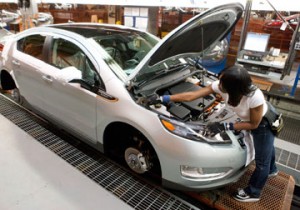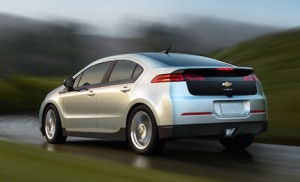A General Motors executive recently told a small group that GM is working on 32 electric car derivatives all based on Voltec, the Chevrolet Volt’s electric drive system. Voltec is GM’s architecture and roadmap for a number of exciting vehicles future vehicles with electric drive systems. This Voltec Propulsion System was formerly called the E-Flex architecture.
Voltec can accommodate an electric drive system that uses a small engine coupled with an electric generator, such as today’s Chevrolet Volt in America, and the similar Opel Ampera for Europe and Japan. If it made economic sense, the engine could be a diesel in Europe, or natural gas in Latin America. Engine and generator could be replaced with a fuel cell. GM could even produce a pure battery-electric like the Nissan Leaf.
Clean Fleet Report is betting on a Buick plug-in hybrid and a pure battery electric car to be announced in the coming months. The Buick will more likely be parallel hybrid configuration. We are also betting that many derivatives in research and development will never be commercialized. Some will depend on battery breakthroughs that deliver more energy from less space and vehicle weight. The Voltec Propulsion System could drive something bigger like an Equinox, or fit in something smaller like a Cruze.
You won’t see the same Volt’s electric motor and battery-pack in a Chevrolet Tahoe or Silverado; the vehicles are too heavy. But we already see 40-foot electric buses and series hybrids. GM Vice President Research and Development in an interview with AutoCar last year stated, “With battery technology as it currently stands, extended-range vehicles that are larger than the Volt — luxury saloons, trucks and SUVs — aren’t really possible; they would simply be too heavy to be efficient. For those types of cars, fuel cells and biofuels are the future. Ironically enough, the E-REV powertrain won’t really package in a much smaller car than the Volt, either. So expect them all to be between four and five meters long.”
Future Batteries Could Deliver 30 to 50 Percent More
New battery technology, however, is promising more energy with less weight and vehicle size. To advance its lithium batteries, GM Ventures invested $7 million in Newark, Calif.-based Envia Systems to provide GM’s battery engineering team with access to advanced lithium-ion cathode technology that delivers higher cell energy density and lower cost. In a separate agreement, GM has secured the right to use Envia’s advanced cathode material for future GM electrically driven vehicles. If successful, Envia could produce 30% to 50% better storage per weight. GM Envia Report.
When I interviewed GM executives last year, they planned to sell 8,000 to 10,000 Volts in 2011. Exciting Volt test drives and soaring gas prices have caused a surge of demand from your neighbor down the street, rental car companies, and giant global fleets such as General Electric.
For a platform appropriate for larger trucks and SUVs, GM has invested in Bright Automotive. For a future of personal vehicles for urban mobility, GM is experimenting with the EN-V built on a Segway platform. For now, look for the action in C and B platform vehicles.
The Volt is an electric vehicle that offers a total driving range of 379 miles, based on EPA estimates. For the first 35 miles, the Volt can drive gas- and tailpipe-free using a full charge of electricity stored in its 16-kWh lithium-ion battery. When the Volt’s battery runs low, a gas-powered engine/generator seamlessly operates to extend the driving range another 344 miles on a full change.
60,000 Chevrolet Volts for 2012
 General Motors’ Detroit-Hamtramck Assembly plant, home of the Chevrolet Volt, will close for four weeks beginning in June for planned upgrades to prepare for a significant increase in the rate of Volt production, along with assembly of the 2013 Chevrolet Malibu midsize sedan.
General Motors’ Detroit-Hamtramck Assembly plant, home of the Chevrolet Volt, will close for four weeks beginning in June for planned upgrades to prepare for a significant increase in the rate of Volt production, along with assembly of the 2013 Chevrolet Malibu midsize sedan.
Already in tight supply, the number of Volts available for delivery to retail customers will be further restricted over the next three months before production resumes and the Volt and the Opel Ampera begin being exported to Europe and China.
“The Volt will be available to customers nationwide by the end of 2011,” said Cristi Landy, director of Chevrolet Volt Marketing. The 2011 Volt was launched in California, New York, Connecticut, Maryland, Michigan, New Jersey, New York, Texas, Virginia and Washington, D.C. But Volt orders have poured in from 48 states. The Volt will be available nationwide and in Europe, China and Canada by the end of this year.
As a result of the plant upgrades, planned Volt and Ampera production capacity this year will increase to 16,000 units, including exports and a fleet of several hundred demonstration units sent to U.S. dealers. In 2012, global production capacity is expected to be 60,000 vehicles with an estimated 45,000 to be delivered in the United States.
“Drivers do not have to compromise,” observes Byron Shaw, General Motors, Managing Director, Advanced Technology. He has already driven his Volt across the U.S. twice. He sited driving 80 miles round trip from San Francisco to Stanford University as an example. In his Volt, he drives down the freeway without range anxiety. Should the battery deplete, the gasoline engine engages. For the same trip in my Nissan LEAF, I only used the freeway for half the trip, driving 65 in the right lane to save electrons. I drove the other half on city streets where range is much better. Not only did I avoid running the AC, for the most part, I kept the fan off. Plug-in hybrid convenience versus pure-electric gasoline free.
For extending range, I look for a charging station. In the future, I will also look for DC Fast Charging stations where I can get up to another 80 miles in 20 minutes. The Volt does not have a fast charge option and does not need one. Another 300 miles of range is available at the nearest gas station. To reach a broad market, GM will ultimately offer a variety of plug-in hybrids and electric cars to meet various customer needs. GM’s future is increasingly electric.

